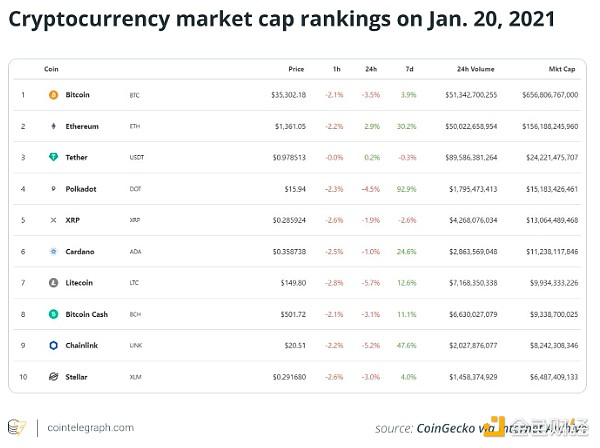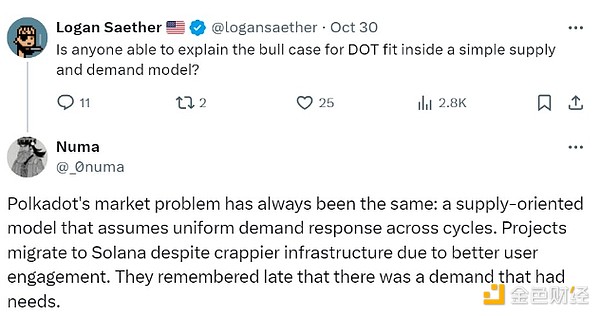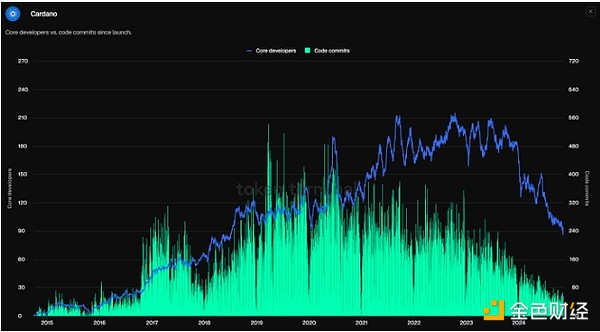Author: Yohan Yun, CoinTelegraph; Compiled by: Tong Deng, Jinse Finance
With the victory of President-elect Donald Trump in the 2024 US presidential election, Bitcoin has set a new historical high.
Trump will return to the White House, and now he seems to be taking a pro-cryptocurrency stance. His campaign team has promised to support the cryptocurrency industry several times, which is different from the previous administration.
As Trump prepares to resume his duties, this article reviews the landscape of cryptocurrencies during his last term. Since then, the industry has undergone major transformations - half of the top 10 tokens during his last term have fallen out of the rankings.

Let's take a look at the current status of the top 10 cryptocurrencies during Trump's previous presidential term.
Bitcoin, the Undisputed King
Bitcoin price on January 20, 2021: $35,302.18
Bitcoin price on November 11, 2024: $82,379.60
Since Trump's last time in the White House, Bitcoin has experienced more twists and turns than the President-elect's campaign trail. First, it hit a new all-time high of around $67,000 in November 2021. Then came FTX - the November 2022 collapse that sent Bitcoin plummeting to $17,000, leaving everyone wondering if the ride was over.
Bitcoin and the global economy have both experienced a bear market, and BTC has struggled to make headway for much of the time.
However, just like any good comeback story, Bitcoin rebounded in 2024 as it found its way onto the US stock market through those shiny new spot ETFs for institutions.
With Trump's victory signaling the end of the crypto supervillain, SEC's Gary Gensler, analysts' eyes are now fixed on the $100,000 mark, as the asset has already breached the $82,000 level.
Additionally, Bitcoin is now hosting digital collectibles like Ordinals (an iteration of non-fungible tokens) and some of the internet's most popular memecoins through Runes. So while Bitcoin remains the gold standard cryptocurrency in the Trump 2.0 era, it has also found some new ways to keep itself entertaining.
From Undisputed Ruler to Second-Layer Lab Rat
Ethereum price on January 20, 2021: $1,361.05
Ethereum price on November 11, 2024: $3,175.47
ETH was the undisputed monarch of the smart contract realm, ruling over a kingdom of decentralized applications. Now, that crown is not as secure, and the network faces some fierce competition.
Solana is a fast, shiny upstart, currently ranked fourth by market cap, leading the pack of "Ethereum killers" blockchains.
However, Ethereum has chosen a different path to maintain relevance. It has not gone after raw speed, but instead opted for scaling through Layer 2 solutions. This helps alleviate the notorious congestion and high fees, but it comes at a cost.
These Layer 2 networks have drained liquidity, fragmenting Ethereum's once-unified domain into a sprawling collection of mini-kingdoms.
In its ongoing evolution, Ethereum also transitioned to a more environmentally-friendly Proof-of-Stake consensus mechanism through The Merge in September 2022.
This upgrade reduced Ethereum's energy consumption by 99% and laid the groundwork for future scalability adjustments (like sharding). The crypto world applauded this, a significant step for Ethereum's sustainability, although it did not bring the explosive price surge some investors had anticipated.
While Bitcoin has been busy breaking records, Ethereum, despite launching its own spot ETF, has been left behind. For now, Ethereum maintains its second position, but merely resting on its laurels as a legacy brand may not be enough to hold on to the crown.
USDT, Unfazed by Skeptics
After the Terra-Luna collapse - which shook confidence in algorithmic stablecoins across the globe - Tether's USDT not only weathered the storm but emerged stronger than ever. USDT is now the third-largest cryptocurrency by market cap, with a valuation of around $120 billion.
Although the company achieved a net profit of $2.5 billion in the third quarter, bringing its total 2024 profits to $7.7 billion, it still has not undergone a comprehensive, full-scale audit. Instead, Tether provides periodic attestations.
So, what's driving the factors? Mainly, US Treasury bills. This makes Uncle Sam's debt Tether's cash cow.
But the massive profits bring massive questions. Without a formal audit, many doubt the solidity of Tether's vaults as claimed. Tether may be a heavyweight, but trust remains the most crucial currency.
From Contender to Rebuilder
Polkadot price on January 20, 2021: $15.94
Polkadot price on November 11, 2024: $5.13
During Trump's previous term, Polkadot was on a roll. With a $17 token market cap and a ranking of fourth among cryptocurrencies, it seemed poised to become the bridge across blockchain ecosystems, promising a future of seamless cross-chain communication. However, by 2024, Polkadot's luster has faded - the price is $4.10, and its market cap has dropped to 21st place.

Polkadot is no longer a top 10 cryptocurrency. Source: Logan Saether
Nevertheless, Polkadot has not raised the white flag. This year, it launched Agile Coretime, a new system that allows developers to purchase processing time directly on its core layer. This is part of the Polkadot 2.0 upgrade, a significant shift from the old auction model.
With the introduction of "Runes" - a playful nod to Bitcoin's Ordinals - Polkadot broke transaction records in December 2023, exceeding 17 million transactions.
However, Polkadot has struggled to captivate its audience. Ethereum and Solana have entrenched their positions in the DeFi space, and other advanced blockchains are hot on their heels.
Bright Prospects for XRP
XRP price on January 20, 2021: $0.285924
XRP price on November 11, 2024: $0.581592
In January 2021, XRP was the fifth-largest cryptocurrency. It has slipped slightly to seventh place, but its growth has been largely positive. Its price has soared from $0.2958 to $0.5355, with its market cap more than doubling to $30.5 billion. Not bad for a cryptocurrency that has endured a legal battle worthy of a courtroom drama.
Ripple Labs, the San Francisco-based company that developed the technology around the XRP Ledger and advocates for its use in cross-border transactions, scored a partial victory in court in 2023.
After years of back-and-forth arguments, the judge ruled that while some private sales of XRP did venture into unregistered securities territory, XRP itself is not a security. This is a half-win for Ripple and a game-changer for the XRP ecosystem, which has long operated under regulatory clouds.
Now, with the elimination of legal uncertainty, XRP is even being discussed as a candidate for an ETF - along with upstarts like Solana. A XRP ETF could open the doors to a more mainstream audience, sparking new excitement among the ups and downs of investors. Therefore, although XRP may have slipped a few places in the rankings, its resilience, steady growth, and newly gained legal clarity portend the start of an unexpected resurgence.
ADA, which occasionally falls out of the top ten crypto rankings
ADA price on January 20, 2021: $0.358738
ADA price on November 11, 2024: $0.592937
In the last election, Cardano firmly held a top ten position, hailed as the "Ethereum killer", tracing its roots back to an Ethereum co-founder. Now, Cardano is a bit like a band from the 90s that still lingers on the charts, occasionally falling out of the top ten.
Critics love to call it a "ghost chain", claiming there is not much construction, and even fewer users. These numbers are indeed eye-opening: the number of Cardano's core developers and active users has declined.

Decline in Cardano's code commits and core developer count. Source: Token Terminal
However, Cardano is not sitting idly by, letting the skeptics have their say. The Alonzo hard fork completed in September 2024, bringing new features and scalability upgrades, indicating it still has some tricks up its sleeve. The network has also entered the Voltaire phase, aiming to achieve decentralized governance, where users can directly participate in decision-making.
Litecoin and Bitcoin Cash: The Original Rebel Contenders for Relevance
Litecoin price on January 20, 2021: $149.80
Litecoin price on November 11, 2024: $77.38
Bitcoin Cash price on January 20, 2021: $501.72
Bitcoin Cash price on November 11, 2021: $438.73
In the early days of cryptocurrencies, Litecoin and Bitcoin Cash were the champions of "spendable" cryptocurrencies - the two currencies vying to become the everyday digital cash.
Litecoin was the "lite" version of Bitcoin, with faster transactions and lower fees, while Bitcoin Cash split off from Bitcoin and made a bold promise: to realize Satoshi Nakamoto's original peer-to-peer cash vision by increasing block sizes and reducing fees.
Both currencies gained loyal followings, and even some merchants joined in, but their paths of development have been more like nostalgic journeys than the revolutions they sought to ignite.
In this world, Bitcoin has entrenched itself as the "digital gold", while newer cryptocurrencies offer advanced features like smart contracts and decentralized applications, leaving Litecoin and Bitcoin Cash struggling to stand out.
Countries banning crypto payments and regulatory red tape have not helped either. While some small-scale adoption remains - like cafes in Townsville, Ljubljana, and parts of Buenos Aires - the widespread use case for everyday transactions has yet to materialize.
Both Litecoin and Bitcoin Cash have fallen out of the top 10 cryptocurrencies by market cap, ranking 25th and 19th respectively.
The Backstory of DeFi
LINK price on January 20, 2021: $20.51
LINK price on November 11, 2024: $13.99
Chainlink is not aiming to become the "digital cash" or "smart contract superstar", but rather the backbone of the crypto world, quietly holding the DeFi world together.
While other cryptocurrencies chase headline news and retail hype, Chainlink has been working to provide price data, weather forecasts, and other real-world information to the blockchains that need it. Since the Trump administration, Chainlink's role as the go-to oracle service has become increasingly entrenched, making it the unsung hero of decentralized finance.
The recent launch of Chainlink 2.0 has added even more power to its oracle network. This upgrade introduced a decentralized oracle network, enabling dynamic non-fungible tokens, automated blockchain functions, and all sorts of new DeFi magic.
With staking finally available, LINK holders can now protect the network and earn rewards - a long-awaited benefit that provides a boost to this data-driven ecosystem. Chainlink is now better equipped to handle more complex tasks, proving it is not only reliable, but also widely applicable.
The LINK token's price has not risen as steadily as its reputation. The token has been buffeted by volatility and competition. New oracle providers have entered the market, and some DeFi projects are building their own oracles.
The Stellar That Didn't Shine
XLM price on January 20, 2021: $0.291680
XLM price on November 11, 2024: $0.109166
Stellar was founded in 2014 by Ripple co-founder Jed McCaleb, aiming to provide fast, low-cost international transactions, connecting everyone from financial institutions to the unbanked.
Since the Trump administration, Stellar has made significant strides in the central bank digital currency (CBDC) space, particularly with a pilot project in Ukraine, testing a digital version of the hryvnia.
But Stellar's journey has not been smooth sailing. Competition in the cross-border payments arena is intensifying. Governments exploring CBDCs often seek centralized solutions or mature platforms like Ethereum.
As the market increasingly favors DeFi-centric chains with high-profile use cases, Stellar's XLM token has taken a hit. As of November 8, 2024, it has fallen from 10th to 35th place.







